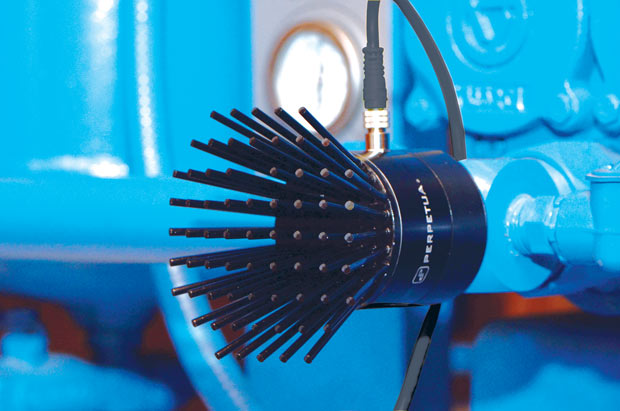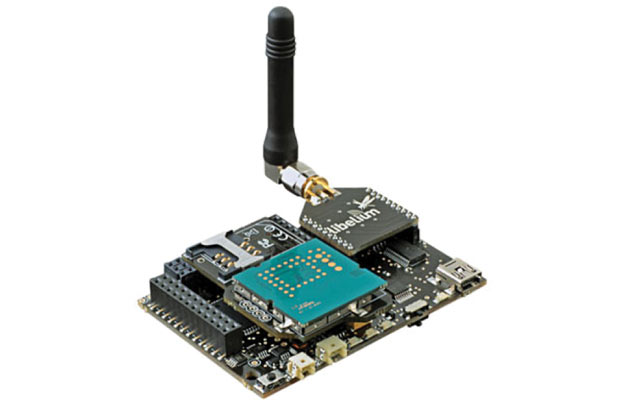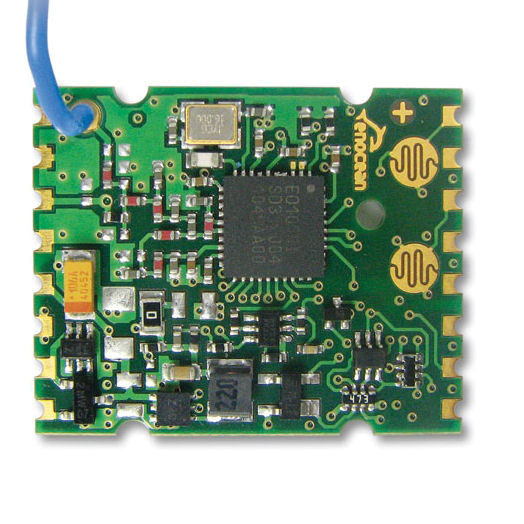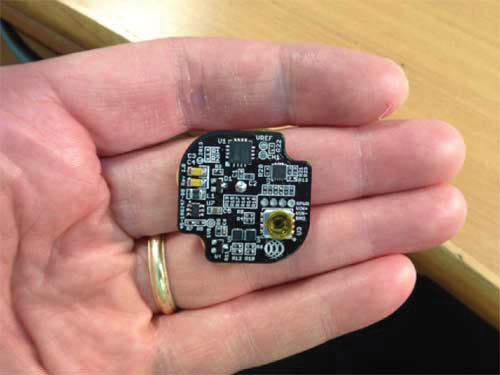
The Perpetua Power Puck is a thermal energy harvester, generating electricity from changes in ambient temperature. Image courtesy of Perpetua.
Latest News
June 1, 2016
 The Perpetua Power Puck is a thermal energy harvester, generating electricity from changes in ambient temperature. Image courtesy of Perpetua.
The Perpetua Power Puck is a thermal energy harvester, generating electricity from changes in ambient temperature. Image courtesy of Perpetua.Sensors in factories are as common as the oil stains on the floor. For generations they have been designed to obey three rules: Be sensitive to the measured property; be insensitive to any other property; and don’t influence the measured property. But, as with everything else touched by the internet, the three rules of sensors are about to be turned on their collective head.
The Internet of Things (IoT) is the buzzword behind the change, and it conjures up images of washing machines sending usage data to the manufacturer’s computer. But in reality, the connectivity is not really between appliances or factory equipment and a computer. The real IoT is a network of sensors attached, embedded and aimed at every kind of manufactured “thing.” Those sensors are digital processors, factors of 10 more sophisticated than any analog sensor ever could be.
MEMS (micro-electro-mechanical systems) sensors are also often deployed in an IoT setup. These tiny accelerometers, gyroscopes and magnetometers represent key enabling technologies for motion tracking and location awareness in portable devices at consumer price points. And they consume as much, if not more, power than more passive sensors. (See “The Sensor Swarm Arrives”)
And they all need power to operate. Nobody imagines the factory of the future with wires going everywhere to power all the IoT sensors required for machine-to-machine communications. But we probably don’t think about changing batteries either. The new generation of smart, networked sensors requires new methods of power.
Energy Harvesting
It is generally acknowledged that battery-powered sensor nodes cannot adequately meet all the requirements of IoT sensors: lifetime, cost, reliability and transmission coverage. Taking advantage of both heat and motion, a new generation of technologies is coming to market that convert ambient energy into electricity, giving digital sensors a built-in source of electricity. Possible power sources include light, heat, magnetic fields or motion. The field is known as energy harvesting.
 Lowering power requirements for sensor networks is as important as finding new sources of energy. The open-source Waspmote wireless sensor network platform from Libelium consumes only 0.07 µAin in hibernation mode. Image courtesy of Libelium.
Lowering power requirements for sensor networks is as important as finding new sources of energy. The open-source Waspmote wireless sensor network platform from Libelium consumes only 0.07 µAin in hibernation mode. Image courtesy of Libelium.According to research by Purushottam Kulkarni of IIT, by exploiting recharge opportunities and tuning performance parameters, energy harvesting sensor nodes have the potential “to address the conflicting design goals of lifetime and performance.”
Demand for self-powered sensors is growing rapidly. According to business research firm Markets & Markets, the market for energy harvesting sensors in 2015 was $974 million; M&M expects the market to grow at a compound annual growth rate of 19% between now and 2022.
Pennsylvania State University is one of many research institutions looking into how to power the Internet of Things. Aman Haque, professor, department of Nuclear and Mechanical Engineering, says the challenge is enormous. “It is estimated that by 2025 basically everything will have its own IP address, just like our computers, and they will be able to send and receive data,” Haque said. The requirement that these new digital sensor nodes send and receive data increases their power consumption. Haque and his team are researching new methods of powering digital sensors. “The challenge is how to get a very small amount of power from almost nothing,” Haque said. “If we’re using light, it would be very low light. If we’re using heat, it would be only as hot as human body temperature.”
Haque’s group is focusing on harvesting energy from very low intensity sources to inexpensively power the wireless sensors. Possible power sources include light, heat, magnetic fields or motion. Side-by-side with the university research, Haque has created a startup to commercialize the energy harvesting technologies they develop.
Three-Way Hitter
One of the leaders in the nascent energy harvesting wireless sensor industry is EnOcean. The Oberhaching, Germany, company holds what may be the oldest patent on sensor energy harvesting technology. The Siemens spin-off now sells energy harvesting for motion (kinetic), solar and thermal conversion. The sensors broadcast their data in three of the most common bands, 868MHz, 902MHz, and 928MHz, for broad global compatibility. “Telegrams” from the sensors (data transmissions) are one millisecond in length at a speed of 125 kilobits per second. Each module has a unique 32-bit ID number.
“Battery-free wireless sensors will make an entry into many different areas of our lives,” says EnOcean CEO Wald Siskens.
Energy Harvesting at Chevron
At the 2015 Emerson Global Users Exchange in Denver, Chevron engineer Greg LaFramboise shared how his company uses thermal energy harvesting technology for both wired and wireless devices. Realized benefits include lower installation costs and the ability to deploy additional monitoring points. Chevron has been replacing legacy field monitoring equipment at production facilities with new wireless sensor. LaFramboise said they found the new sensors improved monitoring ability because of the new automated data acquisition. Additional trending data is now being accumulated from all the remote sensors, at a minimal cost.
But with the increased data sending comes increased power use. Some sensors report in as often as every second. Access to these sensors is often difficult, making reliance on just batteries problematic. Chevron linked their new sensors with the Power Puck thermal energy harvester from Perpetua. LaFramboise said the combination increased Chevron’s flexibility for installation, as one Power Puck could provide power for three transmitters.
Deployments for energy harvesters and sensors at Chevron have included multiple wireless transmitters with a single Power Puck in steam injection fields, and powering mobile test units with Perpetua’s Power Tile energy harvesters. LaFramboise said Chevron benefitted by being able to set update rates as fast as one second in the steam injection applications and eliminated large lead acid batteries in the mobile test unit applications.
“Perpetua’s energy harvesting solutions for both wired and wireless instruments at Chevron overcame the limitations of batteries for steam injection and the lack of reliable remote power in the mobile test units,” says Jon Hofmeister, Perpetua president.
RFID and Energy Harvesting
Radio frequency identification (RFID) is rising in use, as an intelligent but passive sensing device. An RFID tag is enabled by the radio source scanning it for data. Delta Airlines has announced its intentions to use RFID luggage tags to replace the existing barcode technology. Phase IV has long been a significant player in RFID technology. It recently brought to market energy harvesting technology adapted to RFID use.
Phase IV’s energy harvesting circuit captures and stores RF energy for the sensor circuit, keeping it separately from the antenna circuit. Phase IV says it “effectively doubles the read range of the same purely passive standard tag,” making it possible for more power-sensitive sensors to be deployed in any given situation.
From Sensors to Networks
As remote sensing for IoT matures, the sensors in the field will communicate with each other as well as the home base. Imec is collaborating with Renesas, a Japanese firm, on enhancing ultra low power wireless technologies. The goal is to enable short-range communications for industrial and automotive applications.
Renesas has already succeeded in lowering the power consumption in its sensor radios by a factor of three over previous models, and they comply with emerging wireless standards including Bluetooth Low Energy and ZigBee.
 Siemens spin-off EnOcean makes a variety of energy harvesting wireless sensors that run in the most common global frequencies. Image courtesy of EnOcean.
Siemens spin-off EnOcean makes a variety of energy harvesting wireless sensors that run in the most common global frequencies. Image courtesy of EnOcean.Other vendors are also working on reducing power requirements for wireless sensor networks. Libelium sells a line of sensor nodes based on a open-source wireless network platform. More than 2,000 developers have contributed to the Waspmote platform.
More Info
Subscribe to our FREE magazine, FREE email newsletters or both!
Latest News
About the Author
Randall S. Newton is principal analyst at Consilia Vektor, covering engineering technology. He has been part of the computer graphics industry in a variety of roles since 1985.
Follow DE






